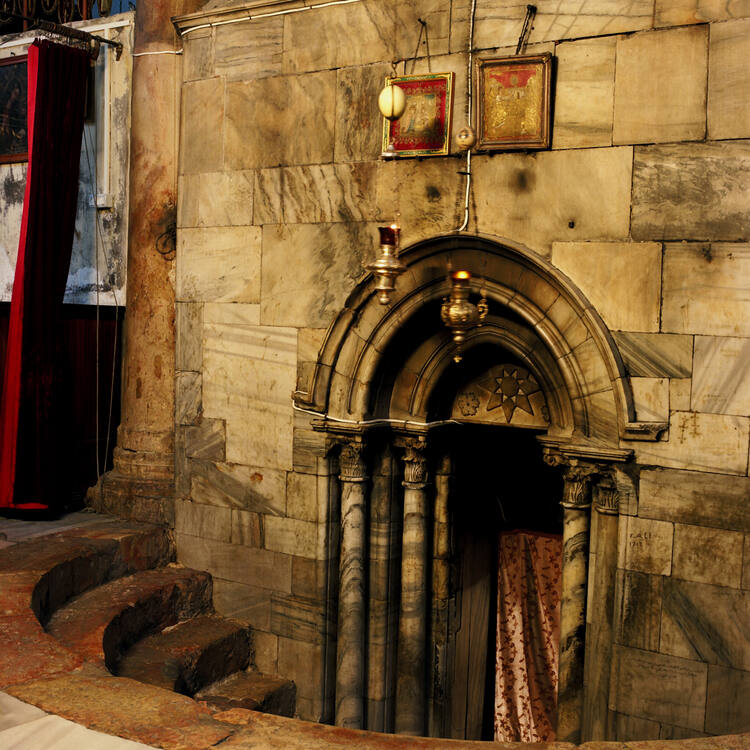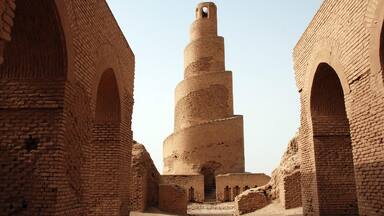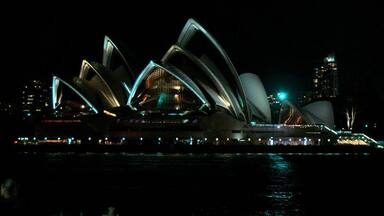Birthplace of Jesus: Church of the Nativity and the Pilgrimage Route, Bethlehem
Birthplace of Jesus: Church of the Nativity and the Pilgrimage Route, Bethlehem
The inscribed property is situated 10 km south of Jerusalem on the site identified by Christian tradition as the birthplace of Jesus since the 2nd century. A church was first completed there in ad 339 and the edifice that replaced it after a fire in the 6th century retains elaborate floor mosaics from the original building. The site also includes Latin, Greek Orthodox, Franciscan and Armenian convents and churches, as well as bell towers, terraced gardens and a pilgrimage route.
Description is available under license CC-BY-SA IGO 3.0
Lieu de naissance de Jésus : l’église de la Nativité et la route de pèlerinage, Bethléem
Le bien inscrit est situé à 10 km au sud de Jérusalem sur les sites que les Chrétiens reconnaissent traditionnellement, depuis le IIe siècle, comme le lieu de naissance de Jésus. Une église y a été construite en 339 et l’édifice qui lui a été substitué après un incendie survenu au VIe siècle conserve des vestiges du sol du bâtiment original, en mosaïques élaborées. Le site comprend également des églises et des couvents grecs, latins, orthodoxes, franciscains et arméniens ainsi que des clochers, des jardins en terrasses et une route de pèlerinage.
Description is available under license CC-BY-SA IGO 3.0
مهد ولادة يسوع المسيح: كنيسة المهد وطريق الحجاج، بيت لحم
وهذا الموقع هو على مسافة 20 كيلومترات من مدينة القدس ويوجد عند المكنة التي يعترف بها أبناء الديانة المسيحية، منذ القرن الثاني، على انها مكان ولادة يسوع المسيح. وبنيت الكنيسة في العام 339. وقد حافظ البناء الذي أعيد تشييده في القرن السادس بعد الحريق الذي أصاب الكنيسة، على بقايا الفسيفساء الأصلية على الأرض. ويشمل الموقع أيضا كنائس وأديرة، يونانية ولاتينية وأرثوذوكسية وفرنسيسكان وأرمن، وكذلك أجراسا وحدائق متنوعة على طول طريق الحجاج.
source: UNESCO/CPE
Description is available under license CC-BY-SA IGO 3.0
耶稣诞生地:伯利恒主诞堂和朝圣线路
这一入选遗产位于耶路撒冷以南10公里,自从公元二世纪以来,就被基督教传统认定为耶稣的诞生地。公元339年,在此建成第一座教堂,公元6世纪的火灾后,在此基础上重建的教堂保留了原有建筑精美的马赛克地板。这一遗产地还包括拉丁、希腊东正教、方济会和亚美尼亚修道院和教堂,以及钟楼、露台花园和一条朝圣路线。
source: UNESCO/CPE
Description is available under license CC-BY-SA IGO 3.0
Базилика Рождества Христова и тропы паломников
Объект расположен в 10 км к югу от Иерусалима. Начиная со 2-го века н.э., это место почитается христианами как место рождения Иисуса Христа. Церковь Рождества была первоначально воздвигнута здесь в 339 г. н. э.. Она была обновлена после пожара в 6–м веке н.э., при этом удалось сохранить оригинальные мозаичные полы. Объект включает католические и православные, включая францисканские и армянские, монастыри и церкви, а также колокольни, террасные сады и тропы паломников.
source: UNESCO/CPE
Description is available under license CC-BY-SA IGO 3.0
El Lugar de Nacimiento de Jesús: Iglesia de la Natividad y ruta de peregrinación en Belén
El sitio inscrito está situado a 10 km al sur de Jerusalén en el lugar en el que los cristianos creen que nació Jesucristo. En el 399 d.C. se construyó una primera iglesia, que fue sustituida por otra en el siglo VI tras ser sustituida por un incendio. En la iglesia actual se conservan suelos de mosaico muy elaborados procedentes del edificio original. El sitio incluye también conventos e iglesias latinas, griegas, ortodoxas, franciscanas y armenias, así como campanarios, jardines en terraza y una ruta de peregrinación.
source: UNESCO/CPE
Description is available under license CC-BY-SA IGO 3.0
イエス生誕の地:ベツレヘムの聖誕教会と巡礼路
エルサレムの南方10kmに位置する生誕協会は、2世紀以降人々によってイエスの生誕地と考えられてきた場所に立つ。339年に創始され、6世紀の火災後に再建されたもので、初期教会建築の顕著な例。構成資産には、巡礼の最終目的地である生誕教会に向かう巡礼路や鐘楼、ひな壇式庭園のほか、ラテン・ギリシャ正教・フランシスコ会・アルメニア教会の修道院や教会なども含まれている。生誕教会の建物の損傷が激しいことから、危機遺産にも同時に登録された。source: NFUAJ
Geboorteplaats van Jezus: Geboortekerk en pelgrimsroute, Bethlehem
Deze plek ligt 10 kilometer ten zuiden van Jeruzalem op de locatie die door de christelijke traditie als de geboorteplaats van Jezus werd aangewezen sinds de 2e eeuw na Christus. In 339 werd er voor het eerst een kerk voltooid. In de 6e eeuw vond er een brand plaats. De huidige kerk die de oude verving, heeft nog steeds de uitgebreide vloermozaïeken van de originele kerk. De omgeving van de Geboorteplaats van Jezus kent verder Latijnse, Grieks-orthodoxe, Franciscaanse en Armeense kloosters en kerken. Er zijn ook klokkentorens, terrasvormige tuinen en een pelgrimsroute te vinden.
Source: unesco.nl
Outstanding Universal Value
Brief synthesis
Bethlehem lies 10 kilometres south of the city of Jerusalem, in the fertile limestone hill country of the Holy Land. Since at least the 2nd century AD people have believed that the place where the Church of the Nativity, Bethlehem, now stands is where Jesus was born. One particular cave, over which the first Church was built, is traditionally believed to be the Birthplace itself. In locating the Nativity, the place both marks the beginnings of Christianity and is one of the holiest spots in Christendom. The original basilica church of 339 AD (St Helena), parts of which survive below ground, was arranged so that its octagonal eastern end surrounded, and provided a view of, the cave. This church is overlaid by the present Church of the Nativity, essentially of the mid-6th century AD (Justinian), though with later alterations. It is the oldest Christian church in daily use[I1] . Since early medieval times the Church has been increasingly incorporated into a complex of other ecclesiastical buildings, mainly monastic. As a result, today it is embedded in an extraordinary architectural ensemble, overseen by members of the Greek Orthodox Church, the Custody of the Holy Land and the Armenian Church, under the provisions of the Status Quo of the Holy Places established by the Treaty of Berlin (1878).
During various periods over the past 1700 years, Bethlehem and the Church of the Nativity have been, and still are, a pilgrim destination. The eastern end of the traditional route from Jerusalem to the Church, known as the Pilgrimage route, marks the road that connects the traditional entrance of Bethlehem, near King David’s Wells with the Church of the Nativity, and extends along the Star Street through the Damascus Gate, or Qos Al-Zarara, the historical gate of the town, towards the Manger Square. The Route continues to be celebrated as the path followed by Joseph and Mary during their trip in Bethlehem during Christmas ceremonies each year, and is followed ceremonially by Patriarchs of the three churches at their several Christmases, and during their official visits to Bethlehem.
The outstanding universal value of the Church of the Nativity and the Pilgrimage Route, Bethlehem, lies, in its association with the birthplace of the founder of a great religion, which for Believers saw the Son of God made man in Bethlehem.
And for the way the fabric of the Church of the Nativity and its associations have combined to reflect the extraordinary influence of Christianity in spiritual and political terms over 1500 years.
Criterion (iv): The Church of the Nativity is an outstanding example of an early church in a remarkable architectural ensemble; which illustrates two significant stages in human history in the 4th-6th centuries AD the conversion of the Roman Empire to Christianity, which led to the development of the Church of the Nativity on the site believed to be associated with the birth of Jesus; and to the power and influence of Christianity in the period of the Crusades that led to the embellishment of the Church of the Nativity and the development of three major convents in its environs.
Criterion (vi): The Church of the Nativity, and the Pilgrimage Route to it, are directly associated with the birth of Jesus, an event of outstanding universal significance, through the buildings of which were constructed in the 4th century AD and re-constructed in the 6th century AD. These are a strong symbol for more than 2 billion Christian believers in the world; and are Holy to Christians as well as to Muslims.
Integrity
The property encompasses the Church of the Nativity and its architectural ensemble, which is composed of the Armenian, Franciscan and Greek Orthodox Convents, as well as an area of terraced land to the east and a short stretch of the Pilgrimage Route. It thus includes all the buildings that form the focus of pilgrimage and the cave that is believed to be the birthplace of Jesus. It thus includes all the buildings that form the focus of pilgrimage and the cave that is believed to be the birthplace of Jesus.
The small area of land to the east that is directly associated with the ensemble, is known to contain as yet systematically unexamined and largely undisturbed evidence of occupation and burial from the early centuries AD back to at least the mid-2nd millennium BC.
The approach to the Church via Star Street and Paul VI Street retains the street width and line fossilized by urban development since c. 1800 AD. This ‘width and line’, as well as defining a working street in a busy town, now formalize a commemorative route for a religious ceremony. The traditional 19th and 20th yellow limestone buildings either side of this route incorporate traditional design and appearance, with living accommodation above and workshops at street level opening out on to the street. These are not part of the property but need to be protected and conserved as part of the approach to the church.
The roof structure of the main Church is highly vulnerable to lack of maintenance and repair. The sharp increase in the number of vehicles, inadequate parking, and small industries within the historic town have produced a polluted environment that is negatively affecting the façades of both the Church of the Nativity and the buildings along the Pilgrimage Route.
Great urban pressure is acknowledged in the surrounding urban areas, to which largely unregulated tourism and traffic contribute. New constructions, some large, are disturbing the traditional urban fabric near the Church of the Nativity and are having a negative impact on views to and from the property ,and on its sense of place and spiritual associations.
Authenticity
Located on the spot believed to be the Birthplace of Jesus Christ for some 2000 years, the Church of the Nativity is one of the most sacred Christian sites in the world since at least the 4th century AD up to the present. The sanctity of the site is maintained by the three churches occupying it. The construction of the church in 339 AD above the grotto, and its reconstruction in 533 AD, commemorates the birth of Jesus and attests to seventeen hundred years-long tradition of belief that this grotto was indeed the birthplace of Jesus Christ.
The association of the place that was believed to be the birthplace of Jesus is documented from the 4th century AD and from then on the buildings added to it have been constructed to enhance this religious significance. The majority of the existing church today dates beck to the 6th century AD, but retains part of the 4th century floor and some parts of its walls and columns, and have 12th century and later additions that are obvious in the icon painting on the columns of the church. The 12th century additions reflect the Crusades that led to one of the upsurges in pilgrimage activity.
From medieval times the church has been supported by monastic communities for which there is strong material evidence. The buildings of one of the monastic complexes date back to at least the 12th century while there is evidence under the others for earlier monastic buildings dating to the 12th century. Apart from the Armenian Convent, most of their current apparent structures date from the 19th and 20th centuries.
All elements of the church associated with the original church, its re-building in the 6th century, and its alterations in the 12th century need to be clearly identified and a conservation plan agreed to ensure repair and restoration respect as much as possible of the existing fabric that is crucial to understanding its significance.
The Church of the Nativity and its monastic complexes and the town of Bethlehem developed in tandem over the centuries. The current lack of control of development, traffic and tourism in the immediate urban surroundings of the Church is threatening this relationship and the ability of the property to convey fully its spiritual links. The exceptionally high number of people within the Church of the Nativity at any one time is impacting adversely on the conservation of the fabric The sharp increase in the number of vehicles, inadequate parking, and small industries within the historic town, have produced a polluted environment that is negatively affecting the façades of both the Church and the buildings along the Pilgrimage Route.
Protection and management requirements
The Church of the Nativity is managed under the terms and provisions of the ‘Status Quo of the Holy Places’, which is implemented by the three churches occupying the place; the Greek Orthodox Church, the Custody of the Holy Land and the Armenian Patriarchate. The management is currently supplemented by an advisory committee formed by the Palestinian President. Each of the three adjacent Convents is maintained under its own arrangement: the Armenian Convent is controlled by the Armenian Patriarchate in the Holy City of Jerusalem; the Greek Orthodox Convent by the Greek Orthodox Patriarchate in the Holy City of Jerusalem; and the Franciscan Convent and the Church of St Catherine by the Custody of the Holy Land, Holy City of Jerusalem.
A technical plan for the restoration of the roof of the Church of the Nativity has been developed by the advisory committee that was formed by the Palestinian president in full cooperation with the three churches in charge of the church. Intervention to restore the roof of the church was indicated as a priority by the international team who worked on the plan, and the works are expected to start during the year.
A Conservation Strategy needs to be developed for the Church of the Nativity to guide the repair and restoration of the roof and future conservation interventions in order to optimise retention of the fabric relating to the 4th, 6th and 12th century interventions. Such a Strategy should synthesize the conclusions of the detailed investigative reports into a clear statement of the significances of the various elements within a comprehensive conservation philosophy for the proposed work. Conservation Plans also need to be developed for the other ecclesiastical buildings.
The second main component, the Pilgrimage Route, principally Star Street, is part of the Municipality of Bethlehem and is therefore covered by the provisions of ‘Building and Planning Law 30, 1996’, of ‘the 'Bethlehem Charter 2008’, of the ‘Guidelines for the Conservation and Rehabilitation of the Historic Towns of Bethlehem, Beit Jala and Beit Sahour, 2010, and of the ‘General Rules for the Protection of the Historic Area and Historic Individual Buildings, Bethlehem, 2006’. Protection’, ‘Conservation’, and ‘Rehabilitation’ are the stated objectives of the last two enactments, and the ‘Charter’, which embodies a statement of principles as well as working practices to achieve those objectives. Nevertheless stronger controls are needed to ensure that the urban context of the property is not eroded. This area is now an Area under Planning, and any interventions are forbidden until the adoption the conservation and management plan and the bylaws that are currently being prepared by CCHP in cooperation with Bethlehem Municipality and MoTA.
A Management Plan will be developed for the overall property by the Committee set up to oversee the roof repairs and this should define an overall management system for the property. This Plan needs to address the urban pressure on the property, tourism and traffic management, protection of views, and the conservation of buildings along the pilgrimage route. The Plan also needs to address the better management of visitors, as the provision of facilities for visitors are impacting adversely on the fabric of the surrounding town.
The municipality of Bethlehem and the Centre for Cultural Heritage Preservation in Bethlehem, in cooperation with the Ministry of Tourism and Antiquities and the Ministry of Local Government are working on preparing conservation and management plans for the historic town of Bethlehem. The works are being implanted under the Heritage For Development Project, which is being funded by the European Commission, are expected to finish in December 2013; upon the completion of the works a conservation plan for the historic town of Bethlehem that includes bylaws for intervention within the historic town, a management plan for the historic town and a manual for interventions shall be at indorsed by Bethlehem municipality. In addition, the team of the municipality is involved in the planning process, and is expected to have the full capacity for the handling of the outputs of the project.






